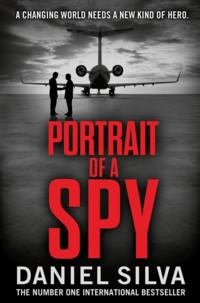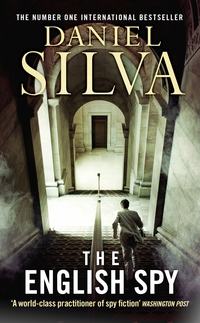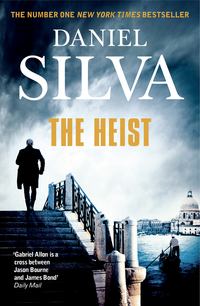
Полная версия
The Fallen Angel
For several hours, Gabriel had the lab to himself. Then, at the thoroughly Roman hour of ten, he heard the snap of the automatic locks, followed by Enrico Bacci’s lumbering plod. Next came Donatella Ricci, an Early Renaissance expert who whispered soothingly to the paintings in her care. After that it was Tommaso Antonelli, one of the stars of the Sistine Chapel restoration, who always tiptoed around the lab in his crepe-soled shoes with the stealth of a night thief.
Finally, at half past ten, Gabriel heard the distinctive tap of Antonio Calvesi’s handmade shoes over the linoleum floor. A few seconds later, Calvesi came whirling through the black curtain like a matador. With his disheveled forelock and perpetually loosened necktie, he had the air of a man who was running late for an appointment he would rather not keep. He settled himself atop a tall stool and nibbled thoughtfully at the stem of his reading glasses while inspecting Gabriel’s work.
“Not bad,” Calvesi said with genuine admiration. “Did you do that on your own, or did Caravaggio drop by to handle the in-painting himself?”
“I asked for his help,” Gabriel replied, “but he was unavailable.”
“Really? Where was he?”
“Back in prison at Tor di Nona. Apparently, he was roaming the Campo Marzio with a sword.”
“Again?” Calvesi leaned closer to the canvas. “If I were you, I’d consider replacing those lines of craquelure along the index finger.”
Gabriel raised his magnifying visor and offered Calvesi the palette. The Italian responded with a conciliatory smile. He was a gifted restorer in his own right—indeed, in their youth, the two men had been rivals—but it had been many years since he had actually applied a brush to canvas. These days, Calvesi spent most of his time pursuing money. For all its earthly riches, the Vatican was forced to rely on the kindness of strangers to care for its extraordinary collection of art and antiquities. Gabriel’s paltry stipend was a fraction of what he earned for a private restoration. It was, however, a small price to pay for the once-in-a-lifetime opportunity to clean a painting like The Deposition.
“Any chance you might actually finish it sometime soon?” Calvesi asked. “I’d like to have it back in the gallery for Holy Week.”
“When does it fall this year?”
“I’ll pretend I didn’t hear that.” Calvesi picked absently through the contents of Gabriel’s trolley.
“Something on your mind, Antonio?”
“One of our most important patrons is dropping by the museum tomorrow. An American. Very deep pockets. The kind of pockets that keep this place functioning.”
“And?”
“He’s asked to see the Caravaggio. In fact, he was wondering whether someone might be willing to give him a brief lecture on the restoration.”
“Have you been sniffing the acetone again, Antonio?”
“Won’t you at least let him see it?”
“No.”
“Why not?”
Gabriel gazed at the painting for a moment in silence. “Because it wouldn’t be fair to him,” he said finally.
“The patron?”
“Caravaggio. Restoration is supposed to be our little secret, Antonio. Our job is to come and go without being seen. And it should be done in private.”
“What if I get Caravaggio’s permission?”
“Just don’t ask him while he has a sword in his hand.” Gabriel lowered the magnifying visor and resumed his work.
“You know, Gabriel, you’re just like him. Stubborn, conceited, and far too talented for your own good.”
“Is there anything else I can do for you, Antonio?” asked Gabriel, tapping his brush impatiently against his palette.
“Not me,” Calvesi replied, “but you’re wanted in the chapel.”
“Which chapel?”
“The only one that matters.” Gabriel wiped his brush and placed it carefully on the trolley. Calvesi smiled.
“You share one other trait with your friend Caravaggio.”
“What’s that?”
“Paranoia.”
“Caravaggio had good reason to be paranoid. And so do I.”
3
THE SISTINE CHAPEL
THE 5,896 SQUARE FEET OF the Sistine Chapel are perhaps the most visited piece of real estate in Rome. Each day, several thousand tourists pour through its rather ordinary doors to crane their necks in wonder at the glorious frescoes that adorn its walls and ceiling, watched over by blue-uniformed gendarmes who seem to have no other job than to constantly plead for silenzio. To stand alone in the chapel, however, is to experience it as its namesake Pope Sixtus IV had intended. With the lights dimmed and the crowds absent, it is almost possible to hear the quarrels of conclaves past or to see Michelangelo atop his scaffolding putting the finishing touches on The Creation of Adam.
On the western wall of the chapel is Michelangelo’s other Sistine masterwork, The Last Judgment. Begun thirty years after the ceiling was completed, it depicts the Apocalypse and the Second Coming of Christ, with all the souls of humanity rising or falling to meet their eternal reward or punishment in a swirl of color and anguish. The fresco is the first thing the cardinals see when they enter the chapel to choose a new pope, and on that morning it seemed the primary preoccupation of a single priest. Tall, lean, and strikingly handsome, he was cloaked in a black cassock with a magenta-colored sash and piping, handmade by an ecclesiastical tailor near the Pantheon. His dark eyes radiated a fierce and uncompromising intelligence, while the set of his jaw indicated he was a dangerous man to cross, which had the added benefit of being the truth. Monsignor Luigi Donati, private secretary to His Holiness Pope Paul VII, had few friends behind the walls of the Vatican, only occasional allies and sworn rivals. They often referred to him as a clerical Rasputin, the true power behind the papal throne, or “the Black Pope,” an unflattering reference to his Jesuit past. Donati didn’t mind. Though he was a devoted student of Ignatius and Augustine, he tended to rely more on the guidance of a secular Italian philosopher named Machiavelli, who counseled that it is far better for a prince to be feared than loved.
Among Donati’s many transgressions, at least in the eyes of some members of the Vatican’s gossipy papal court, were his unusually close ties to the notorious spy and assassin Gabriel Allon. Theirs was a partnership that defied history and faith—Donati, the soldier of Christ, and Gabriel, the man of art who by accident of birth had been compelled to lead a clandestine life of violence. Despite those obvious differences, they had much in common. Both were men of high morals and principle, and both believed that matters of consequence were best handled in private. During their long friendship, Gabriel had acted as both the Vatican’s protector and a revealer of some of its darkest secrets—and Donati, the Holy Father’s hard man in black, had served as his willing accomplice. As a result, the two men had done much to quietly improve the tortured relationship between the world’s Catholics and their twelve million distant spiritual cousins, the Jews.
Gabriel stood wordlessly at Donati’s side and gazed up at The Last Judgment. Near the center of the image, adjacent to the left foot of Christ, was one of two self-portraits Michelangelo had hidden within the frescoes. Here he had depicted himself as St. Bartholomew holding his own flayed skin, perhaps a not-so-subtle rejoinder to contemporary critics of his work.
“I assume you’ve been here before,” said Donati, his sonorous voice echoing in the empty chapel.
“Just once,” said Gabriel after a moment. “It was in the autumn of 1972, long before the restoration. I was posing as a German student traveling Europe. I came here in the afternoon and stayed until the guards forced me to leave. The next day …”
His voice trailed off. The next day, with Michelangelo’s vision of the end times still fresh in his mind, Gabriel entered the foyer of a drab apartment building in the Piazza Annibaliano. Standing before the elevator, a bottle of fig wine in one hand and a copy of A Thousand and One Nights in the other, was a skinny Palestinian intellectual named Wadal Zwaiter. The Palestinian was a member of the terrorist group Black September, perpetrators of the Munich Olympics massacre, and for that he had been secretly sentenced to death. Gabriel had calmly asked Zwaiter to say his name aloud. Then he had shot him eleven times, once for each Israeli butchered at Munich. In the months that followed, Gabriel would assassinate five other members of Black September, the opening act of a distinguished career that lasted far longer than he ever intended. Working at the behest of his mentor, the legendary spymaster Ari Shamron, he had carried out some of the most fabled operations in the history of Israeli intelligence. Now, blown and battered, he had returned to Rome, to the place where it all began. And one of the few people in the world he could trust was a Catholic priest named Luigi Donati.
Gabriel turned his back to The Last Judgment and gazed down the length of the rectangular chapel, past the frescoes by Botticelli and Perugino, toward the little potbellied stove where ballots were burned during papal conclaves. Then he recited, “ ‘The House which King Solomon built for the Lord was sixty cubits long, twenty cubits wide, and thirty cubits high.’ ”
“Kings,” said Donati. “Chapter six, verse two.”
Gabriel lifted his face toward the ceiling. “Your forefathers built this rather simple chapel to the exact dimensions of the Temple of Solomon for a reason. But why? Did they wish to pay tribute to their elder brothers the Jews? Or were they declaring that the old law had been superseded by the new law, that the ancient temple had been brought to Rome, along with the sacred contents of the Holy of Holies?”
“Perhaps it was a little of both,” said Donati philosophically.
“How diplomatic of you, Monsignor.”
“I was trained as a Jesuit. Obfuscation is our strong suit.”
Gabriel pondered his wristwatch. “It’s rather late in the morning for this place to be empty.”
“Yes,” Donati said absently.
“Where are the tourists, Luigi?”
“For the moment, only the museums are open to the public.”
“Why?”
“We have a problem.”
“Where?”
Donati frowned and tilted his head toward the left.

The stairwell leading from the glory of the Sistine Chapel to the most magnificent church in Christendom is decidedly ugly. A gray-green tube with slick cement walls, it deposited Gabriel and Donati into the Basilica, not far from the Chapel of the Pietà. In the center of the nave, a yellow tarpaulin was spread over the unmistakable form of a human corpse. Standing over it were two men. Gabriel knew them both. One was Colonel Alois Metzler, commandant of the Pontifical Swiss Guard. The other was Lorenzo Vitale, chief of the Corpo della Gendarmeria, the Vatican’s 130-member police force. In his previous life, Vitale had investigated government corruption cases for Italy’s powerful Guardia di Finanza. Metzler was retired Swiss Army. His predecessor, Karl Brunner, had been killed in the al-Qaeda terrorist attack on the Vatican.
The two men looked up in unison and watched Gabriel crossing the nave at the side of the second-most powerful man in the Roman Catholic Church. Metzler was clearly displeased. He extended his hand toward Gabriel with the cold precision of a Swiss timepiece and nodded his head once in formal greeting. He was Donati’s equal in height and build but had been blessed by the Almighty with the jutting, angular face of a hound. He wore a dark gray suit, a white shirt, and a banker’s silver necktie. His receding hair was shorn to the length of stubble; small, rimless spectacles framed a pair of judgmental blue eyes. Metzler had friends inside the Swiss security service, which meant that he knew about Gabriel’s past exploits on the soil of his homeland. His presence in the Basilica was intriguing. Strictly speaking, dead bodies at the Vatican fell under the jurisdiction of the gendarmes, not the Swiss Guard—unless, of course, there was an element of papal security involved. If that were the case, Metzler would be free to poke his snout anywhere he pleased. Almost anywhere, thought Gabriel, for there were places behind the walls where even the commander of the palace guard was forbidden to enter.
Donati exchanged a look with Vitale, then instructed the police chief to remove the tarpaulin. It was obvious the body had fallen from a great height. What remained was a split sack of skin filled with shattered bone and organs. Remarkably, the attractive face was largely intact. So was the identification badge around the neck. It stated that the bearer was an employee of the Vatican Museums. Gabriel didn’t bother to read the name. The dead woman was Claudia Andreatti, a curator in the antiquities division.
Gabriel crouched next to the body with the ease of someone used to being in the presence of the newly dead and examined it as though it were a painting in need of restoration. She was dressed, like all the laywomen of the Vatican, professionally but piously: dark trousers, a gray cardigan, a white blouse. Her woolen overcoat was unbuttoned and had arranged itself across the floor like an unfurled cape. The right arm was draped across the abdomen. The left was extended in a straight line from the shoulder, the wrist slightly bent. Gabriel carefully lifted a few strands of the shoulder-length hair from the face, revealing a pair of eyes that remained open and vaguely watchful. The last time he had seen them, they had been appraising him in a stairwell of the museum. The encounter had occurred a few minutes before nine the previous evening. Gabriel was just leaving after a long session before the Caravaggio; Claudia was clutching a batch of files to her breast and heading back to her office. Her demeanor, though somewhat harried, was hardly that of a woman about to kill herself in St. Peter’s. In fact, thought Gabriel, it had been mildly flirtatious.
“You knew her?” asked Vitale.
“No, but I knew who she was.” It was a professional compulsion. Even in retirement, Gabriel couldn’t help but assemble a mental dossier on those around him.
“I noticed you were both working late last night.” The Italian managed to make it sound like an offhand remark, which it wasn’t. “According to the log at the security desk, you exited the museum at 8:47. Dottoressa Andreatti left a short time later, at 8:56.”
“By then, I’d already left the territory of the city-state via St. Anne’s Gate.”
“I know.” Vitale gave a humorless smile. “I checked those logs, too.”
“So I’m no longer a suspect in the death of my colleague?” Gabriel asked sardonically.
“Forgive me, Signor Allon, but people do have a way of dying whenever you show up at the Vatican.”
Gabriel lifted his gaze from the body and looked at Vitale. Though he was now in his early sixties, the police chief had the handsome features and permanent suntan of an aging Italian movie idol, the sort who drives down the Via Veneto in an open-top car with a younger woman at his side. At the Guardia di Finanza, he had been regarded as an unbending zealot, a crusader who had taken it upon himself to eliminate the corruption that had been the scourge of Italian politics and commerce for generations. Having failed, he had taken refuge behind the walls of the Vatican to protect his pope and his Church. Like Gabriel, he was a man used to being in the presence of the dead. Even so, he seemed incapable of looking at the woman on the floor of his beloved Basilica.
“Who found her?” asked Gabriel.
Vitale nodded toward a group of sampietrini standing halfway down the nave.
“Did they touch anything?”
“Why do you ask?”
“She’s barefoot.”
“We found one of her shoes near the baldacchino. The other was found in front of the Altar of St. Joseph. We assume they came off during the fall. Or …”
“Or what?”
“It’s possible she dropped them from the gallery of the dome before jumping.”
“Why?”
“Perhaps she wanted to see whether she really had the nerve to go through with it,” Metzler suggested. “A moment of doubt.”
Gabriel looked heavenward. Just above the Latin inscription at the base of the dome was the viewing platform. Running along the edge was a waist-high metal balustrade. It was enough to make suicide difficult, but not impossible. In fact, every few months, Vitale’s gendarmes had to prevent some poor soul from hurling himself into the blessed abyss. But late in the evening, when the Basilica was closed to the public, Claudia Andreatti would have had the gallery entirely to herself.
“Time of death?” asked Gabriel quietly, as though he were posing the question to the corpse itself.
“Unclear,” replied Vitale.
Gabriel looked around the interior of the Basilica, as if to remind the Italian of their whereabouts. Then he asked how it was possible there was no established time of death.
“Once each week,” Vitale answered, “the Central Security Office disables the cameras for a routine system reset. We do it in the evening when the Basilica is closed. Usually, it’s not a problem.”
“How long does the shutdown last?”
“Nine to midnight.”
“That’s quite a coincidence.” Gabriel looked at the body again. “What do you suppose the odds are that she decided to kill herself during the time the cameras were switched off?”
“Perhaps it wasn’t a coincidence at all,” said Metzler. “Perhaps she chose the time intentionally so there would be no video recording of her death.”
“How would she have known about the cameras being shut down?”
“It’s common knowledge around here.”
Gabriel shook his head slowly. Despite numerous outside threats, terrorist and otherwise, security inside the borders of the world’s smallest country remained startlingly lax. What’s more, those who worked behind the walls enjoyed extraordinary freedom of movement. They knew the doors that were never locked, the chapels that were never used, and the storerooms where it was possible to plot, scheme, or caress the flesh of a lover in complete privacy. They also knew the secret passageways leading into the Basilica. Gabriel knew one or two himself.
“Was there anyone else in the Basilica at the time?”
“Not that we’re aware of,” replied Vitale.
“But you can’t rule it out.”
“That’s correct. But no one reported anything unusual.”
“Where’s her handbag?”
“She left it up in the gallery before jumping.”
“Was anything missing?”
“Not that we know of.”
But there was something missing; Gabriel was certain of it. He closed his eyes and for an instant saw Claudia as she had been the previous evening—the warm smile, the flirtatious glance from her brown eyes, the batch of files she had been clutching to her breast.
And the cross of gold around her neck.
“I’d like to have a look at the gallery,” he said.
“I’ll take you up,” answered Vitale.
“That won’t be necessary.” Gabriel rose. “I’m sure the monsignor will be good enough to show me the way.”
4
ST. PETER’S BASILICA
THERE WERE TWO WAYS TO make the ascent from the main level of the Basilica to the base of the dome—a long, twisting stairwell or an elevator large enough to accommodate two dozen well-fed pilgrims. Donati, an unrepentant smoker, suggested the elevator, but Gabriel headed for the steps instead.
“The elevator is shut down in the afternoon after the last group of tourists is admitted. There’s no way Claudia could have used it late at night.”
“That’s true,” Donati said with a morose glance at his handmade loafers, “but it’s several hundred steps.”
“And we’re going to search every one.”
“For what?”
“When I saw Claudia last night, she was wearing a gold cross around her neck.”
“And?”
“It’s no longer there.”
Gabriel mounted the first step with Donati at his heels and climbed slowly upward. His careful search of the stairwell produced nothing but a few discarded admission tickets and a crumpled flier advertising the services of a less-than-saintly enterprise involving young women from Eastern Europe. At the top of the stairs was a landing. In one direction was the roof terrace; in the other, the viewing gallery for the dome. Gabriel peered over the balustrade at the now-miniaturized figures of Vitale and Metzler, then set out slowly along the catwalk with his eyes lowered toward the time-worn marble. After a few paces, he found the cross. The clasp was intact, but the thin gold chain had been snapped.
“It’s possible she tore it off before climbing over the balustrade,” Donati said, examining the broken chain by the light of one of the dome’s sixteen windows.
“I suppose anything is possible. But the more likely explanation is that the chain was broken by someone else.”
“Who?”
“The person who killed her.” Gabriel was silent for a moment. “Her neck was snapped like a twig, Luigi. I suppose the break could have occurred on impact, but I believe it happened up here. Her killer probably didn’t notice he broke the chain of Claudia’s cross as well. He did notice the shoes, though. That’s why they were found so far apart. He probably hurled them over the barrier before making his escape.”
“How certain are you that she was murdered?”
“As certain as you are.” Gabriel studied Donati’s face carefully. “Something tells me you know more than you’re saying, Luigi.”
“Guilty as charged.”
“Is there anything you wish to confess, Monsignor?”
“Yes,” said Donati, peering down at the floor of the Basilica. “It’s possible the person responsible for Claudia Andreatti’s death might be standing right in front of you.”

They headed out onto the roof terrace of the Basilica to walk among the apostles and the saints. Donati’s black cassock billowed and snapped in the cold wind. In one hand, entwined around his fingers like the beads of a rosary, was Claudia’s gold necklace.
“She was conducting …” Donati paused for a moment, as if searching for the appropriate word. “An investigation,” he said at last.
“What sort of investigation?”
“The only kind we ever do around here.”
“A secret investigation,” said Gabriel. “Ordered by you, of course.”
“At the behest of the Holy Father,” Donati added hastily.
“And the nature of this investigation?”
“As you know, there’s been a debate raging within the art world and the curatorial community over who owns antiquity. For centuries, the great empires of Europe looted the treasures of the ancient world with reckless abandon. The Rosetta Stone, the Elgin Marbles, the great temples of ancient Egypt—the list goes on and on. Now the source countries are demanding the symbols of their cultural heritage be returned. And they often turn to the police and courts for help in getting them back.”
“You were afraid the Vatican Museums were vulnerable?”
“We probably are.” Donati paused along the façade of the Basilica and pointed toward the Egyptian obelisk in the center of the square. “It’s one of eight here in Rome. They were built by craftsmen from an empire that no longer exists and brought here by soldiers of an empire that also no longer exists. Should we send them back to Egypt? What about the Venus de Milo or the Winged Victory of Samothrace? Would they really be better off in Athens than in the Louvre? Would more people see them?”
“You sound like a bit of a hawk on this issue.”
“My enemies often mistake me for a liberal who’s trying to destroy the Church. In reality, despite my Jesuit education, I am as doctrinaire as they come. I believe that great treasures of antiquity should be displayed in great museums.”








